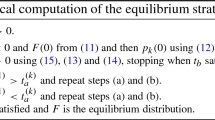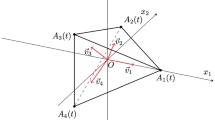Abstract
Motivated by queueing systems playing a key role in the performance evaluation of telecommunication networks, we analyze in this paper the stationary behavior of a fluid queue, when the instantaneous input rate is driven by a continuous-time Markov chain with finite or infinite state space. In the case of an infinite state space and for particular classes of Markov chains with a countable state space, such as quasi birth and death processes or Markov chains of the G/M/1 type, we develop an algorithm to compute the stationary probability distribution function of the buffer level in the fluid queue. This algorithm relies on simple recurrence relations satisfied by key characteristics of an auxiliary queueing system with normalized input rates.
Similar content being viewed by others
References
I. Adan, and J. Resing, “Simple analysis of a fluid queue driven by an M/M/1 queue,” Queueing Systems—Theory and Applications vol. 22 pp. 171–174, 1996.
S. Ahn, and V. Ramaswami, “Fluid flow models and queues—a connection by stochastic coupling,” Communications in Statistics. Stochastic Models vol. 19(3) pp. 325–348, 2003.
S. Ahn, and V. Ramaswami, “Transient analysis of fluid flow models via stochastic coupling,” Communications in Statistics. Stochastic Models vol. 20(1) pp. 71–101, 2004.
D. Anick, D. Mitra, and M. M. Sondhi, “Stochastic theory of a data-handling system with multiple sources,” Bell System Technical Journal vol. 61(8) pp. 1871–1894, 1982.
N. Barbot, and B. Sericola, “Stationary solution to the fluid queue fed by an M/M/1 queue,” Journal of Applied Probability vol. 39 pp. 359–369, 2002.
O. J. Boxma, and V. Dumas, “The busy period in the fluid queue,” Performance Evaluation Review vol. 26 pp. 100–110, 1998.
A. da Silva Soares, and G. Latouche, “Further results on the similarity between fluid queues and QBDs.” In G. Latouche and P. Taylor (eds.), Proceedings of the 4th Int. Conf. on Matrix-Analytic Methods, pp. 89–106, World Scientific: Adelaide, 2002.
B. Igelnik, Y. Kogan, V. Kriman, and D. Mitra, “A new computational approach for stochastic fluid models of multiplexers with heterogeneous sources,” Queueing Systems—Theory and Applications vol. 20 pp. 85–116, 1995.
H. Kobayashi, and Q. Ren, “A mathematical theory for transient analysis of communication networks,” IEICE Transactions on Communications vol.E75-B(12) pp. 1266–1276, 1992.
L. Kosten, “Stochastic theory of data-handling systems with groups of multiple sources.” In H. Rudin and W. Bux (eds.), Proceedings of the IFIP WG 7.3/TC 6 Second International Symposium on the Performance of Computer–Communication Systems, Zurich, Switzerland, pp. 321–331, 1984.
G. Latouche, and V Ramaswami, Introduction to Matrix Analytic Methods in Stochastic Modeling, In ASA-SIAM Series on Statistics and Applied Probability, SIAM, Philadelphia, PA, 1999.
B. Meini, “Solving M/G/1 type Markov chains : recent advances and applications,” Communications in Statistics. Stochastic Models vol. 14 pp. 479–496, 1998.
D. Mitra, “Stochastic fluid models.” In Proceedings of Performance’87, Brussels, Belgium, pp. 39–51, 1987.
D. Mitra, “Stochastic theory of a fluid model of producers and consumers coupled by a buffer,” Advances in Applied Probability vol. 20 pp. 646–676, 1988.
H. Nabli, and B. Sericola, “Performability analysis: a new algorithm,” IEEE Transactions on Computers vol. 45 pp. 491–494, 1996.
H. Nabli, “Asymptotic solution of stochastic fluid models,” Performance evaluation vol. 57 pp. 121–140, 2004.
V. Ramaswami, “Matrix analytic methods for stochastic fluid flows.” In D. Smith and P. Hey (eds.), Proceedings ITC 16, pp. 1019–1030, Elsevier: Edinburgh, 1996.
Q. Ren, and H. Kobayashi, “Transient solutions for the buffer behavior in statistical multiplexing,” Performance evaluation vol. 23 pp. 65–87, 1995.
L. C. G. Rogers, and Z. Shi, “Computing the invariant law of a fluid model,” Journal of Applied Probability vol. 31(4) pp. 885–896, 1994.
L. C. G. Rogers, “Fluid models in queueing theory and Wiener–Hopf factorization of Markov chains,” Annals of Applied Probability vol. 4(2) pp. 390–413, 1994.
S. M. Ross, Stochastic Processes, Wiley, New York, 1983.
B. Sericola, P. R. Parthasarathy, and K. V. Vijayashree, “Exact transient solution of and M/M/1 driven fluid queue,” International Journal of Computer Mathematics vol. 82(6) pp. 659–671, 2005.
B. Sericola, and B. Tuffin, “A fluid queue driven by a Markovian queue,” Queueing Systems—Theory and Applications vol. 31 pp. 253–264, 1999.
B. Sericola, “Transient analysis of stochastic fluid models,” Performance evaluation vol.32 pp. 245–263, 1998.
B. Sericola, “A finite buffer fluid queue driven by a Markovian queue,” Queueing Systems—Theory and Applications vol. 38 pp. 213–220, 2001.
T. E. Stern, and A. I. Elwalid, “Analysis of separable Markov-modulated rate models for information-handling systems,” Advances in Applied Probability vol. 23 pp. 105–139, 1991.
T. Tanaka, O. Hashida, and Y. Takahashi, “Transient analysis of fluid models for ATM statistical multiplexer,” Performance evaluation vol. 23 pp. 145–162, 1995.
E. A. van Dorn, and W. R. Scheinhardt, “A fluid queue driven by an infinite-state birth and death process.” In V. Ramaswami and P. Wirth (eds.), Proceedings ITC 15, pp. 465–475, Elsevier: Amsterdam, 1997.
J. Virtamo, and I. Norros, “Fluid queue driven by an M/M/1 queue,” Queueing Systems—Theory and Applications vol. 16 pp. 373–386, 1994.
Author information
Authors and Affiliations
Corresponding author
Rights and permissions
About this article
Cite this article
Guillemin, F., Sericola, B. Stationary Analysis of a Fluid Queue Driven by Some Countable State Space Markov Chain. Methodol Comput Appl Probab 9, 521–540 (2007). https://doi.org/10.1007/s11009-006-9007-1
Received:
Accepted:
Published:
Issue Date:
DOI: https://doi.org/10.1007/s11009-006-9007-1




